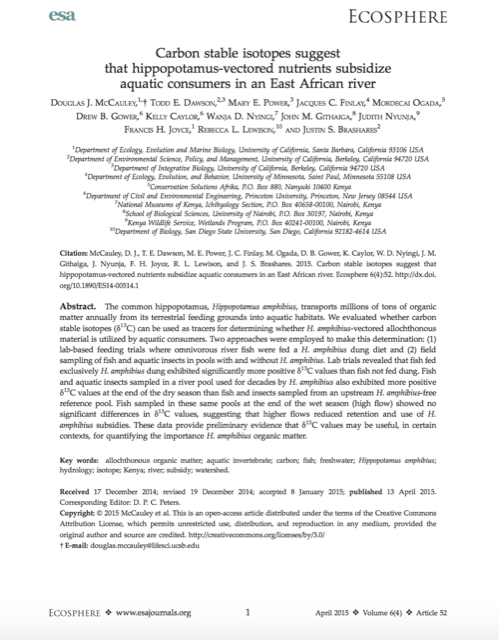Carbon stable isotopes suggest that hippopotamus-vectored nutrients subsidize aquatic consumers in an East African river

McCauley, D.J., Dawson, T.E., Power, M.E., Finlay, J.C., Ogada, M., Gower, D.B., Caylor, K.K., Nyingi, W.D., Githaiga, J.M., Nyunja, J., Joyce, F.H., Lewison, R.L., and Brashares, J.S. (2015) Carbon stable isotopes suggest that hippopotamus-vectored nutrients subsidize aquatic consumers in an East African river, Ecosphere 6(4):52. http://dx.doi. org/10.1890/ES14-00514.1
The common hippopotamus, Hippopotamus amphibius , transports millions of tons of organic matter annually from its terrestrial feeding grounds into aquatic habitats. We evaluated whether carbon stable isotopes (δ 13 C) can be used as tracers for determining whether H. amphibius -vectored allochthonous material is utilized by aquatic consumers. Two approaches were employed to make this determination: (1) lab-based feeding trials where omnivorous river fish were fed a H. amphibius dung diet and (2) field sampling of fish and aquatic insects in pools with and without H. amphibius . Lab trials revealed that fish fed exclusively H. amphibius dung exhibited significantly more positive δ 13 C values than fish not fed dung. Fish and aquatic insects sampled in a river pool used for decades by H. amphibius also exhibited more positive δ 13 C values at the end of the dry season than fish and insects sampled from an upstream H. amphibius -free reference pool. Fish sampled in these same pools at the end of the wet season (high flow) showed no significant differences in δ 13 C values, suggesting that higher flows reduced retention and use of H. amphibius subsidies. These data provide preliminary evidence that δ 13 C values may be useful, in certain contexts, for quantifying the importance H. amphibius organic matter.
